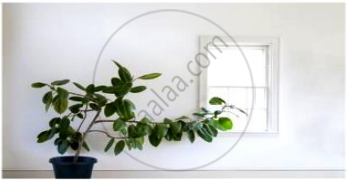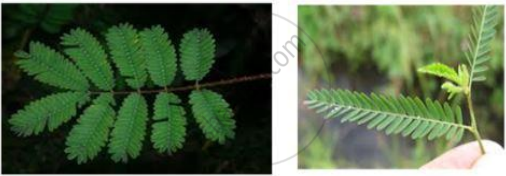Advertisements
Advertisements
Question
Mohan and Rohit observed that shoots of a plant growing in shade bend towards the sunlight. Whereas, leaves of ‘Touch me not’ plant fold and droop soon after touching. They were curious to know how these movements occur in plants.

A. Shoots of a plant bending towards light

B. Folding of leaves Touch me not plant
In order to help them understand the movements in the plants, answer the following questions:
- What causes the bending of shoots in the plants as shown in figure A?
OR - What causes the folding of the leaves in ‘Touch me not’ plant as shown in figure B?
- Compare the movement of growth of the pollen tube towards ovule with the movements shown in part A of the above figure.
- Compare the movement shown in figure B with the movement of body parts in the animals.
Long Answer
Solution
- Causes the bending of shoots in the plants:
- The bending of shoots of plants is a response to the stimulus and a directional, growth-related movement.
- When growing plants detect sunlight, a hormone called auxin, synthesized at the shoot tip, helps the cells to grow longer.
- When light comes from one side of the plant, auxin diffuses to the shady side of the shoot.
- This auxin concentration stimulates the shoot cells to grow longer on the side of the shoot, that is, away from the light. Thus, the plant appears to bend towards light.
OR
- Causes the folding of the leaves in ‘Touch me not’ plant:
- Leaves of ‘Touch me not’ plant respond to the stimulus by showing growth-independent movement.
- These plants use electrical-chemical means to convey the information from cell to cell.
- Movement happens at a point different from the point of touch.
- Plant cells change shape by changing the amount of water in them, resulting in swelling or shrinking and, therefore, changing shape.
- The growth of pollen tubes towards the ovule is an example of chemotropism, whereas the bending of shoots towards sunlight is an example of phototropism.
- The movement of body parts in the animals:
- Although both plants and animals show electrical-chemical means to convey information from cell to cell, unlike nerve cells in animals, there is no specialized tissue in plants for the conduction of information.
- In animal cells, change in shape occurs because of the specialized proteins found in muscle cells; plant cells change shape by changing the amount of water in them.
shaalaa.com
Is there an error in this question or solution?
